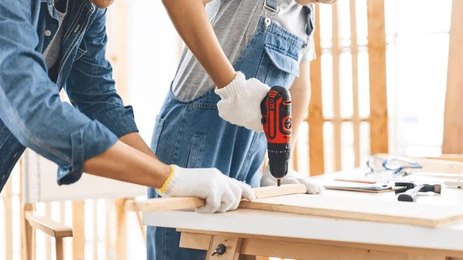Image Credit: Shutterstock
Woodworking enthusiasts know that a well-equipped woodshop is the foundation of any successful project. From crafting intricate furniture pieces to building sturdy outdoor structures, having the right tools at hand can make all the difference. A properly outfitted woodshop allows woodworkers to bring their creative visions to life while ensuring precision, efficiency, and safety in their work.
Essential Hand Tools for Woodworking
Measuring and Marking Tools
Accurate measurements and precise markings are crucial for successful woodworking projects. A combination square is an indispensable tool, serving multiple functions. It checks 90° and 45° angles, acts as a depth gage, and marks lines along boards. For longer measurements, a 6′ folding wooden rule offers reliable accuracy compared to retractable tape measures.
A mechanical pencil with 0.7mm lead creates sharp, crisp lines without breaking easily. For even more precision, a marking knife scores razor-thin lines. A scratch awl is useful for starting screws, accurately initiating drill holes, and scribing lines, especially when working on installations like bi fold doors.
Cutting Tools
Hand saws remain essential in every woodworker’s toolkit. The Japanese saw, or nokogiri, is particularly efficient. It cuts on the pull stroke, requiring less energy and providing more control. For intricate cuts, a coping saw excels at creating complex shapes and curves.
Power saws greatly enhance cutting capabilities. A circular saw is versatile and portable, ideal for both rough carpentry and fine woodworking with the right blade. Jigsaws are perfect for curved cuts and interior work, while table saws serve as the centerpiece of many workshops, offering precision in ripping lumber and cutting panels.
Shaping Tools
A router is another versatile shaping tool. It can hollow out areas, cut profiles for moldings, and add decorative edges. Routers are also used for cutting joinery, such as dovetails and dados. With a wide range of available profiles, routers can meet numerous woodworking requirements.
Must-Have Power Tools for Your Woodshop
Stationary Power Tools
A well-equipped woodshop relies on several essential stationary power tools. The tablesaw stands as the cornerstone of most furniture and cabinet woodshops, excelling at making precise, straight cuts. For beginners, a hybrid saw like the Ridgid 13A 10-in. Tablesaw offers great accuracy and dust collection while plugging into a conventional garage outlet.
The bandsaw is ideal for cutting curves, with blade widths ranging from 1/8-inch to one inch or more. The Grizzly 555, with its 14- x 14-in. cast iron top, can cut wood up to six inches thick.
For smoothing and achieving consistent thickness, a planer is indispensable. Lunchbox planers like the DeWalt DW-735 accommodate 13-in. boards and have two speeds. A jointer, such as the Grizzly 6 x 48, flattens the face or edge of a board, removing twists and warps.
Portable Power Tools
Portable power tools offer flexibility and convenience in woodworking projects. A drill and impact driver combo, like the DeWalt 20-Volt Max Lithium Ion Drill Driver/Impact Driver Combo Kit, provides versatility with compact design and LED lights.
Routers are highly versatile tools. The Makita D-Handle Router features a 2-1/4-hp motor and comfortable pistol-grip handle. For lighter tasks, a palm router like the Bosch Colt 1.25 HP Variable-Speed Palm Router Combination Kit is ideal. If you’re looking for a place to service your tools, you might want to search for a motor garage near me to find convenient options nearby
Random orbital sanders, such as the Bosch Sander, are practical for smoothing wood. They feature variable speed and dust collection systems. For flattening rough lumber and fitting doors, a handheld power planer like the DeWalt 3-1/4-Inch Hand Planer is invaluable.
Also Read: Influencers-gone-wild The Controversy and Its Cultural Implications
The Craftsman 20V Cordless Variable Speed Jigsaw simplifies cutting curves, while the Porter Cable Plate Joiner is perfect for gluing up boards. For cutting full sheets of plywood, a track saw like the Makita LXT Lithium-Ion Cordless 6-1/2-in. Plunge Circular Saw offers accuracy and excellent dust collection.
Safety Equipment Every Woodworker Needs
Woodworking can be a rewarding hobby, but it comes with inherent risks. To ensure a safe and enjoyable experience, woodworkers need to prioritize safety equipment. This essential gear protects against potential hazards and helps prevent injuries in the workshop.
Personal Protective Equipment
Personal Protective Equipment (PPE) forms the first line of defense against woodworking hazards. Safety glasses with side shields or a full face mask are crucial to protect the eyes from flying wood chips and debris. Hearing protection, such as earplugs or earmuffs, is necessary when using power tools to prevent long-term hearing damage.
Respiratory protection is equally important. Woodworkers should use dust masks for basic cutting tasks and respirators with HEPA filters when working with toxic fumes or finishes. Sawdust is a known carcinogen, making proper respiratory protection essential.
Appropriate clothing also plays a role in safety. Long-sleeved shirts and full-length pants offer better protection than shorts and T-shirts. Loose or baggy clothing should be avoided as it can get caught in moving parts. Proper footwear is also crucial for workshop safety.
Workshop Safety Devices
In addition to personal protective gear, woodworkers should utilize various safety devices in their workshops. Push sticks and push pads are invaluable tools for keeping hands away from spinning blades on table saws, bandsaws, and router tables. These simple devices can prevent serious injuries and should be used consistently.
A well-stocked first aid kit is essential in every workshop. It allows for quick response to minor injuries and can be crucial in more serious situations. Woodworkers should also ensure that all power tools have their manufacturer-supplied blade guards in place. These guards serve a vital safety function and should only be removed when absolutely necessary, with the tool de-energized.
Organizing Your Woodshop Tools
Storage Solutions
Efficient storage is crucial for a well-organized woodshop. Woodworkers can utilize various methods to keep their tools accessible and protected. One effective approach is to use French cleats, which offer flexibility in arranging tools on walls. This system allows for easy rearrangement as needs change.
For smaller tools, repurposing everyday items can be surprisingly effective. Old glasses cases, for instance, serve as excellent protectors for scrapers and plane irons. Labeling these cases helps quickly identify their contents.
Plastic bins prove invaluable for storing hardware and small items. Creating a custom shelf unit to house these bins can significantly improve organization. For larger tools, a mobile tool wall on casters provides a versatile storage solution, allowing easy access and movement within the shop.
Tool Maintenance Tips
Proper maintenance is essential to keep woodworking tools in peak condition. After each use, tools should be cleaned with a mild soap and water solution, then thoroughly dried to prevent rust. For power tools, regular cleaning helps prevent dust build-up and overheating.
Lubrication is crucial for moving parts. Applying a quality tool oil to bearings and other moving components every 40 hours of operation or monthly keeps tools running smoothly. This practice not only enhances performance but also extends the tool’s lifespan.
Sharpening blades regularly is another vital aspect of tool maintenance. Keeping blades sharp not only improves work quality but also reduces the risk of accidents. Additionally, storing tools in a dry, clean place and using rust protectants can significantly prolong their life and maintain their condition.
Conclusion
A well-equipped woodshop is key to bringing creative woodworking projects to life. From essential hand tools like measuring instruments and chisels to powerful machinery such as table saws and routers, having the right tools at your fingertips can make a world of difference. Safety equipment, including protective gear and workshop devices, plays a crucial role to ensure a secure working environment. Proper organization and maintenance of these tools are also vital to keep the workspace efficient and the equipment in top shape.
To wrap up, this guide offers a comprehensive overview of the tools and equipment needed to set up a functional woodshop. Whether you’re just starting out or looking to upgrade your existing workshop, understanding these essentials will help you create a space that boosts your craftsmanship and productivity. Remember, investing in quality tools and prioritizing safety will pave the way for enjoyable and successful woodworking experiences.
FAQs
1. What are the essential hand tools every woodworker should have?
Answer: Essential hand tools include measuring and marking tools like combination squares and marking knives, cutting tools such as hand saws and coping saws, and shaping tools like chisels and routers. These tools are crucial for precise work and creating detailed joinery.
2. What are the benefits of having stationary power tools in a woodshop?
Answer: Stationary power tools, such as table saws, bandsaws, and planers, provide stability, accuracy, and the ability to handle larger projects efficiently. They are ideal for making precise cuts, shaping wood, and achieving consistent thickness, making them foundational for any well-equipped woodshop.
3. How do portable power tools differ from stationary tools?
Answer: Portable power tools, such as drills, routers, and sanders, offer flexibility and convenience for various tasks and can be easily moved around the workshop. They are typically used for tasks that require mobility or for detailed work where stationary tools might be impractical.
4. What safety equipment is crucial for woodworking?
Answer: Crucial safety equipment includes safety glasses or face shields, hearing protection, dust masks or respirators, and appropriate clothing. Additionally, using push sticks, having a well-stocked first aid kit, and ensuring all power tools have proper blade guards are essential for workshop safety.
5. How should tools be organized in a woodshop?
Answer: Effective organization can be achieved using storage solutions like French cleats, plastic bins, and mobile tool walls. Proper labeling and keeping tools accessible yet protected help maintain an efficient and tidy workspace.
Also Read: Influencers-gone-wild The Controversy and Its Cultural Implications




